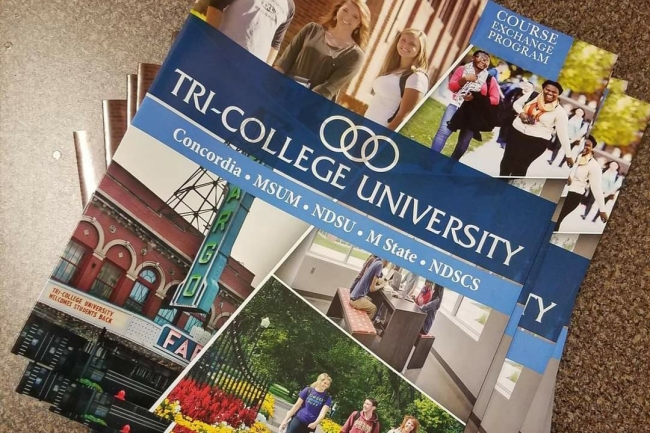You have /5 articles left.
Sign up for a free account or log in.

Tri-College University will sunset in 2024 after five higher education institutions have found it redundant.
Timothy Flakoll/Tri-College University
In 1970, three colleges in the upper Midwest came together—arguably ahead of their time—to share academic programs. Fifty years later, now a union of five colleges, they’re killing off the central organization created to manage that work, citing budgetary constraints and advances in technology, among other factors.
Tri-College University, a nonprofit—and despite its name, not an academic institution—was created to help institutions in Minnesota and North Dakota work together to enroll students. It will cease to exist after 2024, according to Carrie Brimhall, president of Minnesota State Community and Technical College and chair of Tri-College University’s board. The board includes the presidents of all five participating institutions.
“It’s an organization that created partnerships when people didn’t want to be partners as much as they do now,” Brimhall said.
The nonprofit was originally a consortium of North Dakota State University, Minnesota State University and Minnesota-based Concordia College. In 2015, North Dakota State College of Science and Minnesota State Community and Technology College—both two-year colleges—became members.
The five institutions serve more than 35,000 students across two states, and Tri-College was designed to help students across the five campuses take classes from the other institutions in a seamless way. Its processes have adapted over the years, moving from manually filling out paperwork and faxing it to today, when any student can sign up for courses with a digital PDF form.
At its peak, 678 students per year took advantage of the joint system’s benefits, taking classes on member campuses. Roughly 400 took courses through Tri-College in the last year, a number that’s stayed consistent over Brimhall’s six years with the organization.
That low usage, in part, led the five presidents to reassess the need for Tri-College in today’s environment.
Like many institutions across the U.S., the five in the consortium face constrained resources and are seeking ways to control their spending. The member institutions will collectively save several hundred thousand dollars by closing the nonprofit. Each institution pays a different amount, based on how many students each serves, according to Brimhall. Tri-College used the funds to pay its three employees and to cover the costs of marketing to students.
“What maybe used to look like competition is now seen as efficiency,” Brimhall said. “If we’re going to be involved, asking our teams to collaborate, then let’s just do that; we don’t need an organization to do that, even though they’ve done great work.”
Tim Flakoll, provost at Tri-College University, characterizes the move as “decentralizing” operations.
The institutions announced earlier this month that a task force would meet in January to tackle a new process for working together across all five colleges and universities while Tri-College winds down over the next year. The institutions will create a memorandum of understanding to create a new course-exchange model so students will not have any disruption during the sunsetting of Tri-College. There are no details yet as to what that will look like.
“Everyone seems focused on keeping students first in all decisions, and it’s always important to continue the process of looking at better ways of continuous improvement,” said Tri-College’s Flakoll, who also serves as the director of operations at North Dakota State University.
Part of the redirection, Brimhall said, would be discussing how to reach a larger number of students to better utilize the services.
One of the major takeaways from the discussions surrounding Tri-College’s dissolution, according to Brimhall, was the need to focus on recruiting students from beyond the region, given Tri-College’s local focus. She said the task force will look at programs across the five institutions in a holistic manner, identifying which niches each college serves and where there is room to grow in those programs, which she said she hopes can ultimately garner more students from beyond the region.
“It’s one example of, if Tri-College isn’t facilitating external enrollment growth to be brought into the area, then it’s missing the mark,” Brimhall said. “We don’t have enough people; we need the universities to be full.”
Despite the uncertainty of what the new partnership will look like, Flakoll said he believes every option and potential avenue should be on the table.
“I’m part of the Apollo generation,” he said. “I think anything is doable.”









